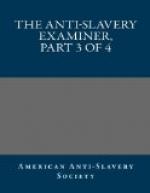C. MARRIOTT.”
TESTIMONY OF REUBEN G. MACY.
“During the winter of 1818 and 19, I resided on an island near the mouth of the Savanna river, on the South Carolina side. Most of the slaves that came under my particular notice, belonged to a widow and her daughter, in whose family I lived. No white man belonged to the plantation. Her slaves were under the care of an overseer who came once a week to give orders, and settled the score laid up against such as their mistress thought deserved punishment, which was from twenty-five to thirty lashes on their naked backs, with a whip which the overseer generally brought with him. This whip had a stout handle about two feet long, and a lash about four and a half feet. From two to four received the above, I believe nearly every week during the winter, sometimes in my presence, and always in my hearing. I examined the backs and shoulders of a number of the men, which were mostly naked while they were about their labor, and found them covered with hard ridges in every direction. One day, while busy in the cotton house, hearing a noise, I ran to the door and saw a colored woman pleading with the overseer, who paid no attention to her cries, but tied her hands together, and passed the rope over a beam, over head, where was a platform for spreading cotton, he then drew the rope as tight as he could, so as to let her toes touch the ground; then stripped her body naked to the waist, and went deliberately to work with his whip, and put on twenty-five or thirty lashes, she pleading in vain all the time. I inquired, the cause of such treatment, and was informed it was for answering her mistress rather ‘short.’”
“A woman from a neighboring plantation came where I was, on a visit; she came in a boat rowed by six slaves, who, according to the common practice, were left to take care of themselves, and having laid them down in the boat and fallen asleep, the tide fell, and the water filling the stern of the boat, wet their mistresses trunk of clothes. When she discovered it, she called them up near where I was, and compelled them to whip each other, till they all had received a severe flogging. She standing by with a whip in her hand to see that they did not spare each other. Their usual allowance of food was one peck of corn per week, which was dealt out to them every first day of the week, and such as were not there to receive their portion at the appointed time, had to live as they could during the coming week. Each one had the privilege of planting a small piece of ground, and raising poultry for their own use which they generally sold, that is, such as did improve the privilege which were but few. They had nothing allowed them besides the corn, except one quarter of beef at Christmas which a slave brought three miles on his head. They were allowed three days rest at Christmas. Their clothing consisted of a pair of trowsers and jacket, made of whitish woollen cloth called negro cloth. The women had nothing but a petticoat, and a very short short-gown, made of the same king of cloth. Some of the women had an old pair of shoes, but they generally went barefoot. The houses for the field slaves were about fourteen feet square, built in the coarsest manner, having but one room, without any chimney, or flooring, with a hole at the roof at one end to let the smoke out.




